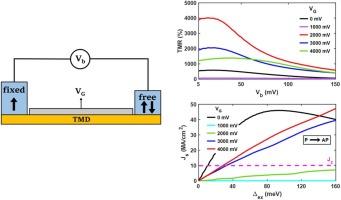Gate-controllable two-dimensional transition metal dichalcogenides for spintronic memory
IF 5.8
2区 材料科学
Q2 CHEMISTRY, PHYSICAL
引用次数: 0
Abstract
Rapid technological advancement has increased the demand for high-speed, low-power devices, particularly applied in artificial intelligence (AI) and the Internet of Things (IoT). Limitations of traditional memory devices underscore the urgency for high-performance, energy-efficient memory technologies. On the other hand, developing two-dimensional (2D) material-based devices is indispensable for next-generation memory and three-dimensional integration circuit (3D-IC) systems. Here, we propose a gate-controllable spin valve utilizing transition metal dichalcogenides (TMDs) to meet the urgent need. A high tunneling magnetoresistance (TMR) of over 4000% can be reached in reading with the help of the controlled gate. Moreover, under ungated conditions, a giant spin current density with an ultralow power consumption of 80 μW and a high spin-polarized ratio of 0.9 can be achieved, enabling high-speed and energy-efficient switching during writing. According to our design, the gate-controllable system can prevent undesired mixed reading and writing operations. Our results highlight TMDs as a promising material in spintronic memory devices.

用于自旋电子存储器的栅极可控二维过渡金属二卤化物
技术的飞速发展增加了对高速、低功耗设备的需求,尤其是在人工智能(AI)和物联网(IoT)领域。传统存储器件的局限性凸显了对高性能、高能效存储器技术的迫切需求。另一方面,开发基于二维(2D)材料的器件对于下一代存储器和三维集成电路(3D-IC)系统是不可或缺的。在此,我们提出了一种利用过渡金属二钙化物(TMDs)的栅极可控自旋阀,以满足这一迫切需求。在可控栅极的帮助下,读取时的隧穿磁阻(TMR)可达到 4000% 以上。此外,在非栅极条件下,还能实现 80 μW 的超低功耗和 0.9 的高自旋极化比的巨大自旋电流密度,从而在写入过程中实现高速、节能的开关。根据我们的设计,栅极可控系统可以防止不必要的混合读写操作。我们的研究结果凸显了 TMD 作为自旋电子存储器件材料的前景。
本文章由计算机程序翻译,如有差异,请以英文原文为准。
求助全文
约1分钟内获得全文
求助全文
来源期刊

Journal of Alloys and Compounds
工程技术-材料科学:综合
CiteScore
11.10
自引率
14.50%
发文量
5146
审稿时长
67 days
期刊介绍:
The Journal of Alloys and Compounds is intended to serve as an international medium for the publication of work on solid materials comprising compounds as well as alloys. Its great strength lies in the diversity of discipline which it encompasses, drawing together results from materials science, solid-state chemistry and physics.
 求助内容:
求助内容: 应助结果提醒方式:
应助结果提醒方式:


